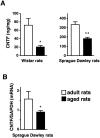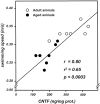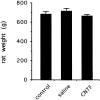Ciliary neurotrophic factor is a regulator of muscular strength in aging
- PMID: 9952403
- PMCID: PMC6786012
- DOI: 10.1523/JNEUROSCI.19-04-01257.1999
Ciliary neurotrophic factor is a regulator of muscular strength in aging
Abstract
Ciliary neurotrophic factor (CNTF) participates in the survival of motor neurons and reduces the denervation-induced atrophy of skeletal muscles. Experiments performed in rats show a decrease in peripheral CNTF synthesis during aging, associated with an overexpression of its alpha-binding receptor component by skeletal muscles. Measurement of sciatic nerve CNTF production and of the muscular performance developed by the animals revealed a strong correlation between the two studied parameters (r = 0.8; p < 0.0003). Furthermore, the twitch and tetanic tensions measured in the isolated soleus skeletal muscle in 24-month-old animals increased 2. 5-fold by continuous in vivo administration of CNTF. Analyses of the activation level of leukemia inhibitory factor receptor beta- and signal transducer and activator of transcription 3-signaling molecules in response to exogenous CNTF revealed an increased tyrosine phosphorylation positively correlated with the twitch tension developed by the soleus muscle of the animals.
Figures






Similar articles
-
Changes in CNTF receptor alpha expression in rat skeletal muscle during the recovery period after hindlimb suspension.Acta Physiol Scand. 1998 Jul;163(3):273-8. doi: 10.1046/j.1365-201x.1998.00355.x. Acta Physiol Scand. 1998. PMID: 9715739
-
Trophic effect of ciliary neurotrophic factor on denervated skeletal muscle.Cell. 1994 Feb 11;76(3):493-504. doi: 10.1016/0092-8674(94)90113-9. Cell. 1994. PMID: 8313470
-
Ciliary neurotrophic factor: regulation of acetylcholinesterase in skeletal muscle and distribution of messenger RNA encoding its receptor in synaptic versus extrasynaptic compartments.Neuroscience. 1996 Jul;73(2):613-22. doi: 10.1016/0306-4522(96)00033-4. Neuroscience. 1996. PMID: 8783275
-
Ciliary neurotrophic factor as a motor neuron trophic factor.Perspect Dev Neurobiol. 1996;4(1):65-74. Perspect Dev Neurobiol. 1996. PMID: 9169920 Review.
-
The tripartite CNTF receptor complex: activation and signaling involves components shared with other cytokines.J Neurobiol. 1994 Nov;25(11):1454-66. doi: 10.1002/neu.480251111. J Neurobiol. 1994. PMID: 7852997 Review.
Cited by
-
Muscle ciliary neurotrophic factor receptor α promotes axonal regeneration and functional recovery following peripheral nerve lesion.J Comp Neurol. 2013 Sep 1;521(13):2947-65. doi: 10.1002/cne.23324. J Comp Neurol. 2013. PMID: 23504871 Free PMC article.
-
The relationship between ciliary neurotrophic factor (CNTF) genotype and motor unit physiology: preliminary studies.BMC Physiol. 2005 Sep 23;5:15. doi: 10.1186/1472-6793-5-15. BMC Physiol. 2005. PMID: 16181490 Free PMC article.
-
Rapid protein kinase C-dependent reduction of rat skeletal muscle voltage-gated sodium channels by ciliary neurotrophic factor.J Physiol. 2005 Jun 15;565(Pt 3):827-41. doi: 10.1113/jphysiol.2005.084681. Epub 2005 Apr 14. J Physiol. 2005. PMID: 15831538 Free PMC article.
-
The amino acid exchange R28E in ciliary neurotrophic factor (CNTF) abrogates interleukin-6 receptor-dependent but retains CNTF receptor-dependent signaling via glycoprotein 130 (gp130)/leukemia inhibitory factor receptor (LIFR).J Biol Chem. 2014 Jun 27;289(26):18442-50. doi: 10.1074/jbc.M114.568857. Epub 2014 May 6. J Biol Chem. 2014. PMID: 24802752 Free PMC article.
-
Effects of aging on muscle fibre type and size.Sports Med. 2004;34(12):809-24. doi: 10.2165/00007256-200434120-00002. Sports Med. 2004. PMID: 15462613 Review.
References
-
- Apfel SC, Arezzo JC, Moran M, Kessler JA. Effects of administration of ciliary neurotrophic factor on normal motor and sensory peripheral nerves in vivo. Brain Res. 1993;604:1–6. - PubMed
-
- Chevalier S, Fourcin M, Robledo O, Wijdenes J, Pouplard-Barthelaix A, Gascan H. Interleukin-6 family of cytokines induced activation of different functional sites expressed by gp130 transducing protein. J Biol Chem. 1996;271:14764–14772. - PubMed
-
- Curtis R, Adryan KM, Zhu Y, Harkness PJ, Lindsay RM, DiStefano PS. Retrograde axonal transport of ciliary neurotrophic factor is increased by peripheral nerve injury. Nature. 1993;365:253–255. - PubMed
-
- Davis S, Aldrich TH, Valenzuela DM, Wong V, Furth ME, Squinto SP, Yancopoulos GD. The receptor for ciliary neurotrophic factor. Science. 1991;253:59–63. - PubMed
-
- Davis S, Aldrich TH, Stahl N, Pan L, Taga T, Kishimoto T, Ip NY, Yancopoulos GD. LIFRβ and gp130 as hetero-dimerizing signal transducers of the tripartite CNTF receptor. Science. 1993a;260:1805–1808. - PubMed
Publication types
MeSH terms
Substances
LinkOut - more resources
Full Text Sources
Medical
